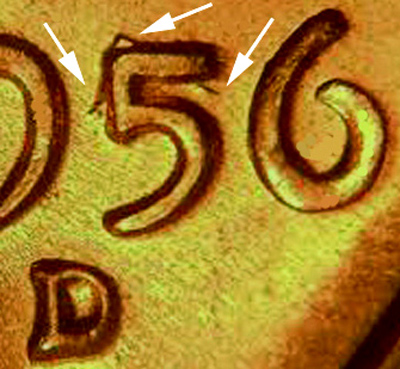PART II. Die Varieties:
Repunched Date:
1956-D Lincoln cent with repunched 5 (controversial)
Definition: A repunched date is produced when a numeral (or several numerals) is punched more than once into a working die, with movement of the punch or die between impacts. On the coin, this results in two overlapping numbers of the same type. A repunched date always involves the same numerals. If different numerals are involved, then we call it an overdate.
Repunched dates should not be confused with doubled dies, re-engraved dates, or misplaced dates.
For U.S. coins, the era of repunched dates ended in 1908. Beginning in 1909, the date was placed on the master hub or the master die. As a result, any claims of repunched dates later than 1908 must be greeted with extreme skepticism.

The 1956-D Lincoln cent pictured above is believed by some to have a partially tilted, extra 5 beneath the normal 5. Those who suspect this is a repunched date argue that it is a fouled-up master die was re-used as a working die. While this is possible, it seems unlikely. The horizontal bar seems unaccountably thin, while the vertical bar terminates abruptly and has an unexplained dimple at its base. Skeptics argue that this is a simulacrum produced by two accidental die gouges or die dents.